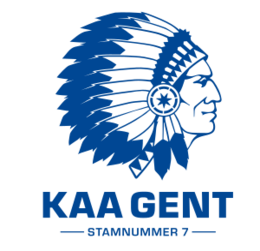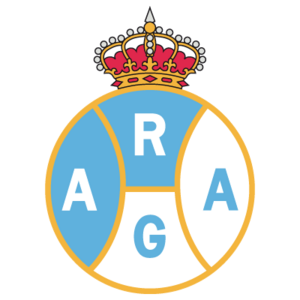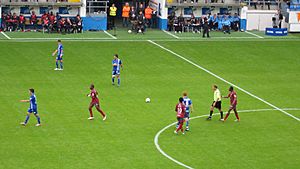KAA Gent facts for kids
 |
||||
| Full name | Koninklijke Atletiek Associatie Gent | |||
|---|---|---|---|---|
| Nickname(s) | De Buffalo's (The Buffalos) Gantoise | |||
| Founded | 1864 (as a gymnastics association) 1900 (as a football association) |
|||
| Ground | Planet Group Arena | |||
| Capacity | 20,175 | |||
| Chairman | Sam Baro | |||
| Sporting Director | Arnar Viðarsson | |||
| Head coach | Ivan Leko | |||
| League | Belgian Pro League | |||
| 2024–25 | Belgian Pro League, 6th of 16 | |||
|
||||
KAA Gent is a professional sports club from the city of Ghent in Belgium. The club is most famous for its football team. They play in the Belgian Pro League, which is the top football league in Belgium.
The team's nickname is De Buffalo's (The Buffalos). This name came from a visit by the famous American showman Buffalo Bill to Ghent a long time ago. The club's logo even features a Native American chief. Their team colors are blue and white.
KAA Gent has won the Belgian league championship once, in the 2014–15 season. They have also won the Belgian Cup four times. From 1920 to 2013, they played at the Jules Ottenstadion. Now, their home stadium is the modern Planet Group Arena.
The club started as a gymnastics and athletics group in 1864, making it one of Belgium's oldest sports clubs. The football part of the club began in 1900. Besides football, KAA Gent still has teams for track and field and field hockey.
Contents
History of the Club
How It All Began
In 1864, a group was formed in Ghent to promote gymnastics. Over time, it grew and added more sports. The football team was started in 1900 by students from a nearby college. At first, they wore black and white, but soon changed to the blue and white colors they use today.
In the early years, the team played in lower divisions. They moved to a new field in 1913, but it burned down during World War I. In 1914, the club was given the title "Royal" and became known as ARA La Gantoise.
In 1920, the team moved to the Jules Ottenstadion, which would be their home for over 90 years. They spent many years moving between the first and second divisions of Belgian football.
First Major Trophies
The 1950s were a strong period for the club. They finished second in the league in the 1954-55 season. Their first major trophy came in 1964 when they won the Belgian Cup. This victory allowed them to play in a European competition for the first time.
The 1970s were a difficult time, as the team was relegated down to the Third Division. However, they fought their way back. By the 1980s, they were a strong team again, winning the Belgian Cup for a second time in 1984.
Modern Success
The club returned to the top division in 1989 and has stayed there ever since. In the 1991-92 season, they had a great run in the UEFA Cup, reaching the quarter-finals. This was their best European result for a long time.
In 2010, KAA Gent won the Belgian Cup for a third time. In 2013, they moved into their new home, the Ghelamco Arena (now called the Planet Group Arena).
The club's greatest moment came on May 21, 2015. They defeated Standard Liège 2–0 to win the Belgian Pro League for the first time in their history. This meant they qualified directly for the UEFA Champions League.
In the Champions League, they surprised everyone. They made it past the group stage, becoming only the second Belgian team to do so. They were eventually knocked out by the German team Wolfsburg, but it was a historic season for the club.
Rivalries
KAA Gent's biggest rival is Club Brugge. Their matches are called the "Battle of Flanders" because the two clubs are from the two biggest cities in the Flanders region of Belgium. There is a strong sense of local pride in these games.
Honours
'Winners' (1): 2014–15 Runners-up (3): 1954–55, 2009–10, 2019–20
- Belgian Cup
'Winners' (4): 1963–64, 1983–84, 2009–10, 2021–22 Runners-up (2): 2007–08, 2018–19
- Belgian Super Cup
'Winners' (1): 2015 Runners-up (3): 1983–84, 2010, 2022
European Record
This table shows how KAA Gent has performed in European competitions.
- As of July 25, 2025
| Competition | Played | Won | Drew | Lost | GF | GA | GD | Win% |
|---|---|---|---|---|---|---|---|---|
| UEFA Champions League | 13 | 4 | 1 | 8 | 14 | 23 | −9 | 30.77 |
| Cup Winners' Cup | 4 | 1 | 1 | 2 | 2 | 5 | −3 | 25.00 |
| UEFA Cup / UEFA Europa League | 81 | 28 | 21 | 32 | 108 | 122 | −14 | 34.57 |
| UEFA Europa Conference League | 15 | 8 | 2 | 5 | 19 | 10 | +9 | 53.33 |
| Total | 113 | 41 | 25 | 47 | 143 | 160 | −17 | 36.28 |
Legend: GF = Goals For. GA = Goals Against. GD = Goal Difference.
Players
Current Squad
As of July 25, 2025
|
|
Famous Former Players
Many great players have worn the KAA Gent shirt.
- Maurice Willems is the club's all-time top scorer, with 185 goals between 1952 and 1962.
- Armand Seghers played the most games for the club, with 507 appearances from 1949 to 1960.
- Roland Storme won the Belgian Golden Shoe award in 1959 while playing for Gent.
- Mbark Boussoufa won many awards while at the club, including Pro-Player of the Year.
- Jonathan David was the league's joint top scorer in 2019-20 before moving to a bigger club.
- Leon Mokuna from Congo became the first African player in the Belgian league when he joined Gent in 1957.
Jean-Claude Bouvy Trophy
The Jean-Claude Bouvy Trophy is an award given each year to the most valuable player of KAA Gent. It was started in 1979 and named after Jean-Claude Bouvy, a former player who died in a car crash in 1986.
Some famous winners include Bryan Ruiz, Laurent Depoitre, and Jonathan David. Goalkeeper Frédéric Herpoel won the award four years in a row from 2002 to 2005.
See also
 In Spanish: K. A. A. Gante para niños
In Spanish: K. A. A. Gante para niños



